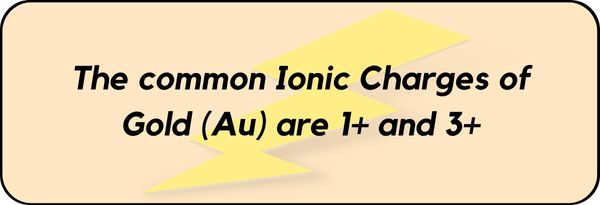
The common Ionic Charges of Gold (Au) are 1+ and 3+.
But the question is how can you find the ionic charge on Gold (Au)?
Well, gold is a transition element and all the transition and post-transition elements have a variable ionic charge.
The ionic charge of gold (or any other transition or post transition elements) depends on what it is bonded with.
So let’s try to find out the ionic charge of Gold (Au) using some examples.
You can also refer to the below video from which you will learn to find charge of any ion.
How to find the ionic charge of Gold (Au)?
As I mentioned earlier, the ionic charge of Gold (Au) can be found out by looking at what it is bonded with.
So let’s take examples of compounds of Gold (Au) like AuCl, AuCl3, AuF3, etc.
(Note: Gold is the noble of the noble metals. It does not easily react with any other elements. But under moist conditions, gold shows reactions with halogens)
Example 1: AuCl
In AuCl, the Gold (Au) is bonded to Chlorine (Cl).
You know that the ionic charge of Cl is 1-.
So you can easily say that the ionic charge of Au should be 1+, then only it will get canceled out.
Hence the ionic charge of Gold in AuCl is 1+.
Example 2: AuCl3
In AuCl3, the Gold (Au) is bonded to Chlorine (Cl).
And again, you know that the ionic charge of Cl is 1-.
So here also you can easily say that the ionic charge of Au should be 3+, then only it will get canceled out.
Hence the ionic charge of Gold in AuCl3 is 3+.
Example 3: AuF3
Similarly in AuF3, the Gold (Au) is bonded to Fluorine (F).
And you know that the ionic charge of F is 1-.
So from this, you can easily say that the ionic charge of Au should be 3+, then only it will get canceled out.
Hence the ionic charge of Gold in AuF3 is 3+.
In this way, Gold can have variable charges depending on what it is bonded to.
But as seen from the above examples,
The most common charges of Gold (Au) are 1+ and 3+.
I hope you have understood why gold has variable ionic charges.
Check out some other related topics for your practice.
Related topics:
Charge of Cesium (Cs)
Charge on SO2 (Sulfur dioxide)
Charge of Arsenic (As)
Charge on Sulfuric acid (H2SO4)
Charge on Nitric acid (HNO3)
Jay is an educator and has helped more than 100,000 students in their studies by providing simple and easy explanations on different science-related topics. With a desire to make learning accessible for everyone, he founded Knords Learning, an online learning platform that provides students with easily understandable explanations.
Read more about our Editorial process.
